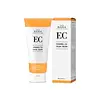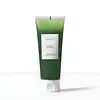What's inside
What's inside
 Key Ingredients
Key Ingredients

 Benefits
Benefits

 Concerns
Concerns

 Ingredients Side-by-side
Ingredients Side-by-side

Aloe Barbadensis Leaf Extract
EmollientPropanediol
SolventGlycerin
HumectantTocopheryl Acetate
AntioxidantCaprylic/Capric Triglyceride
MaskingCetearyl Alcohol
EmollientIsononyl Isononanoate
EmollientDimethicone
EmollientNiacinamide
Smoothing1,2-Hexanediol
Skin ConditioningCetearyl Olivate
Hydrogenated Polydecene
EmollientCetyl Ethylhexanoate
EmollientSorbitan Olivate
EmulsifyingSqualane
EmollientGlyceryl Stearate
EmollientCetearyl Glucoside
EmulsifyingSodium Hyaluronate
HumectantCeramide NP
Skin ConditioningPanthenol
Skin ConditioningAllantoin
Skin ConditioningDipotassium Glycyrrhizate
HumectantHydroxyethyl Acrylate/Sodium Acryloyldimethyl Taurate Copolymer
Emulsion StabilisingAdenosine
Skin ConditioningArtemisia Vulgaris Extract
Skin ConditioningMelissa Officinalis Leaf Extract
Skin ConditioningLavandula Angustifolia Flower Extract
CleansingRosa Damascena Extract
MaskingCamellia Sinensis Leaf Extract
AntimicrobialPolysorbate 60
EmulsifyingAloe Barbadensis Leaf Extract, Propanediol, Glycerin, Tocopheryl Acetate, Caprylic/Capric Triglyceride, Cetearyl Alcohol, Isononyl Isononanoate, Dimethicone, Niacinamide, 1,2-Hexanediol, Cetearyl Olivate, Hydrogenated Polydecene, Cetyl Ethylhexanoate, Sorbitan Olivate, Squalane, Glyceryl Stearate, Cetearyl Glucoside, Sodium Hyaluronate, Ceramide NP, Panthenol, Allantoin, Dipotassium Glycyrrhizate, Hydroxyethyl Acrylate/Sodium Acryloyldimethyl Taurate Copolymer, Adenosine, Artemisia Vulgaris Extract, Melissa Officinalis Leaf Extract, Lavandula Angustifolia Flower Extract, Rosa Damascena Extract, Camellia Sinensis Leaf Extract, Polysorbate 60
Artemisia Princeps Leaf Extract 70%
Skin ConditioningButylene Glycol
HumectantWater
Skin ConditioningAloe Barbadensis Leaf Juice
Skin ConditioningGlycerin
HumectantAcrylates/C10-30 Alkyl Acrylate Crosspolymer
Emulsion StabilisingTromethamine
Buffering1,2-Hexanediol
Skin ConditioningPolyglyceryl-4 Caprate
EmulsifyingCaprylyl Glycol
EmollientMorus Alba Bark Extract
Skin ConditioningAllantoin
Skin ConditioningSodium Hyaluronate
HumectantPinus Densiflora Leaf Extract
AntimicrobialCamellia Sinensis Leaf Extract
AntimicrobialChrysanthemum Indicum Flower Extract
Skin ConditioningRhus Semialata Gall Extract
Skin ConditioningScutellaria Baicalensis Root Extract
AstringentLonicera Japonica Flower Extract
Skin ConditioningSalicornia Herbacea Extract
Skin ConditioningEthylhexylglycerin
Skin ConditioningDipotassium Glycyrrhizate
HumectantCupressus Sempervirens Leaf Oil
MaskingPentylene Glycol
Skin ConditioningPogostemon Cablin Leaf Oil
MaskingSalvia Officinalis Oil
MaskingCitrus Limon Leaf Oil
MaskingPinus Sylvestris Leaf Oil
MaskingJuniperus Mexicana Oil
MaskingMentha Arvensis Leaf Oil
MaskingAspalathus Linearis Extract
Skin ConditioningCommiphora Myrrha Resin Extract
Skin ConditioningPerilla Frutescens Leaf Extract
MaskingYucca Schidigera Root Extract
Skin ConditioningGlycyrrhiza Glabra Root Extract
BleachingCaramel
Cosmetic ColorantChlorophyllin-Copper Complex
AntioxidantLimonene
PerfumingArtemisia Princeps Leaf Extract 70%, Butylene Glycol, Water, Aloe Barbadensis Leaf Juice, Glycerin, Acrylates/C10-30 Alkyl Acrylate Crosspolymer, Tromethamine, 1,2-Hexanediol, Polyglyceryl-4 Caprate, Caprylyl Glycol, Morus Alba Bark Extract, Allantoin, Sodium Hyaluronate, Pinus Densiflora Leaf Extract, Camellia Sinensis Leaf Extract, Chrysanthemum Indicum Flower Extract, Rhus Semialata Gall Extract, Scutellaria Baicalensis Root Extract, Lonicera Japonica Flower Extract, Salicornia Herbacea Extract, Ethylhexylglycerin, Dipotassium Glycyrrhizate, Cupressus Sempervirens Leaf Oil, Pentylene Glycol, Pogostemon Cablin Leaf Oil, Salvia Officinalis Oil, Citrus Limon Leaf Oil, Pinus Sylvestris Leaf Oil, Juniperus Mexicana Oil, Mentha Arvensis Leaf Oil, Aspalathus Linearis Extract, Commiphora Myrrha Resin Extract, Perilla Frutescens Leaf Extract, Yucca Schidigera Root Extract, Glycyrrhiza Glabra Root Extract, Caramel, Chlorophyllin-Copper Complex, Limonene
Ingredients Explained
These ingredients are found in both products.
Ingredients higher up in an ingredient list are typically present in a larger amount.
1,2-Hexanediol is a synthetic liquid and another multi-functional powerhouse.
It is a:
- Humectant, drawing moisture into the skin
- Emollient, helping to soften skin
- Solvent, dispersing and stabilizing formulas
- Preservative booster, enhancing the antimicrobial activity of other preservatives
Allantoin is a soothing ingredient known for its protective and moisturizingg properties. Because of this, it is often added to products with strong active ingredients.
Studies show higher concentrations of this ingredient can promote wound healing.
Though it can be derived from the comfrey plant, allantoin is produced synthetically for cosmetic products to ensure purity.
Learn more about AllantoinCamellia Sinensis Leaf Extract is derived from the leaves of the tea plant. Black tea, green tea, and oolong tea are all harvested from this plant.
This ingredient has many skin benefits:
This ingredient contains polyphenols, a strong antioxidant. Antioxidants help fight off molecules that damage skin cells.
On top of that, the antioxidants in green tea neutralize free-radicals from the sun. This gives the skin some extra UV protection, but should not replace sunscreen.
Many components of tea have anti-inflammatory properties.
Polyphenols and L-theanine help soothe the skin and reduce irritation. The caffeine in Camellia Sinensis Leaf Extract helps calm inflamed blood vessels.
Other compounds found in tea include: Vitamin Bs, linoleic acid, magnesium, calcium, iron, and zinc.
Research has shown both drinking Camellia Sinensis Leaf Tea and applying it to the skin can help boost skin elasticity and hydration. Studies also show using tea extract may reduce sebum, or oil, production.
Learn more about Camellia Sinensis Leaf ExtractDipotassium Glycyrrhizate comes from licorice root.
Extracts of licorice have demonstrated to have antibacterial, anti‐inflammatory, antiviral, antioxidant properties.
One component, glabridin, has extra potent antioxidant and soothing properties. It has also been found to block pigmentation from UVB rays in guinea pigs.
Licorice Root also contains a flavonoid. Flavonoids are a natural substance from in plants. Flavonoids also have antioxidant properties.
Another component, glycyrrhizin, has been found to have anti-inflammatory and antimicrobial benefits. This may make licorice root extract effective at treating acne. However, more research is needed to support this.
Liquiritin is one of the flavone compounds found in licorice. It has been found to help lighten skin by preventing tyrosinase from reacting with tyrosine. When the two react, protein is converted to melanin. Melanin is the substance in your body that gives your features pigmentation.
Licorice root is native to Southern Europe and Asia. It has been used in traditional Chinese medicine to help with respiratory issues.
Learn more about Dipotassium GlycyrrhizateGlycerin is already naturally found in your skin. It helps moisturize and protect your skin.
A study from 2016 found glycerin to be more effective as a humectant than AHAs and hyaluronic acid.
As a humectant, it helps the skin stay hydrated by pulling moisture to your skin. The low molecular weight of glycerin allows it to pull moisture into the deeper layers of your skin.
Hydrated skin improves your skin barrier; Your skin barrier helps protect against irritants and bacteria.
Glycerin has also been found to have antimicrobial and antiviral properties. Due to these properties, glycerin is often used in wound and burn treatments.
In cosmetics, glycerin is usually derived from plants such as soybean or palm. However, it can also be sourced from animals, such as tallow or animal fat.
This ingredient is organic, colorless, odorless, and non-toxic.
Glycerin is the name for this ingredient in American English. British English uses Glycerol/Glycerine.
Learn more about GlycerinSodium Hyaluronate is hyaluronic acid's salt form. It is commonly derived from the sodium salt of hyaluronic acid.
Like hyaluronic acid, it is great at holding water and acts as a humectant. This makes it a great skin hydrating ingredient.
Sodium Hyaluronate is naturally occurring in our bodies and is mostly found in eye fluid and joints.
These are some other common types of Hyaluronic Acid:
Learn more about Sodium Hyaluronate